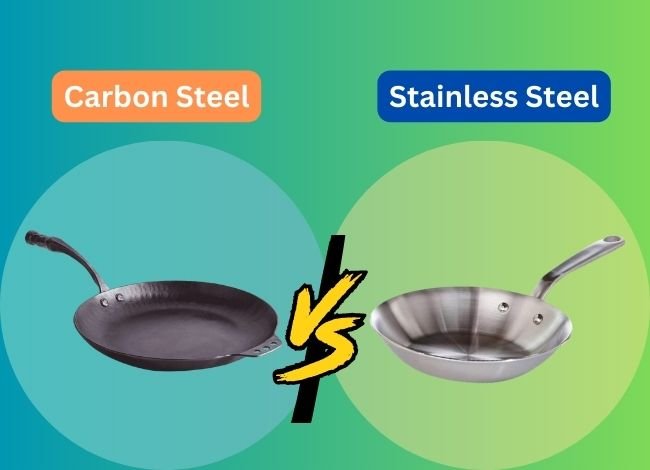Carbon steel and stainless steel pans are popular choices in the world of cookware. Both materials have unique features and benefits, making it challenging to decide which type is best for your kitchen. In this article, we will comprehensively compare carbon steel and stainless steel pans, including a comparison table, to help you make an informed decision.
Comparison Table:
Feature |
Carbon Steel Pans |
Stainless Steel Pans |
|---|---|---|
| Material | High carbon and iron content | Steel alloy with chromium and nickel |
| Weight | Lighter than stainless steel pans | Heavier than carbon steel pans |
| Heat conductivity | Excellent heat conductivity | Good heat conductivity |
| Heat distribution | Even heat distribution | Even heat distribution |
| Heat responsiveness | High heat responsiveness | Moderate heat responsiveness |
| Reactivity | Can react with acidic foods | Non-reactive with acidic foods |
| Seasoning | Requires seasoning | Does not require seasoning |
| Non-stick properties | Develops non-stick surface with seasoning | May require oil or butter for non-stick performance |
| Durability | Durable, but prone to rust if not maintained | Highly durable and resistant to corrosion |
| Maintenance | Needs regular maintenance and seasoning | Low maintenance and dishwasher safe |
| Price range | Budget-friendly to mid-range | Mid-range to premium pricing |
Material: Carbon steel pans are made from a combination of high carbon and iron content, giving them excellent heat conductivity and even heat distribution. Stainless steel pans are made from a steel alloy that includes chromium and nickel, making them resistant to corrosion and staining.
Weight: Carbon steel pans are generally lighter than stainless steel pans, making them easier to handle and maneuver.
Heat Conductivity: Carbon steel pans have excellent heat conductivity, which allows for quick and even heating. Stainless steel pans have good heat conductivity but may not heat up as quickly as carbon steel pans.
Heat Distribution: Both carbon steel and stainless steel pans provide even heat distribution across the surface, ensuring consistent cooking results.
Heat Responsiveness: Carbon steel pans have high heat responsiveness, allowing for precise temperature control while cooking. Stainless steel pans have moderate heat responsiveness, which can make temperature adjustments slower in comparison.
Reactivity: Carbon steel pans can react with acidic foods, potentially altering the taste and appearance of the dish. Stainless steel pans are non-reactive and suitable for cooking acidic foods.
Seasoning: Carbon steel pans require regular seasoning to maintain their non-stick properties and prevent rust. Stainless steel pans do not require seasoning.
Non-stick Properties: With proper seasoning, carbon steel pans can develop a non-stick surface. Stainless steel pans may require oil or butter to prevent food from sticking.
Durability: Carbon steel pans are durable but prone to rust if not properly maintained. Stainless steel pans are highly durable and resistant to corrosion.
Maintenance: Carbon steel pans need regular maintenance, including seasoning and thorough drying after use to prevent rust. Stainless steel pans are low-maintenance and dishwasher safe.
Price Range: Carbon steel pans are typically budget-friendly to mid-range in price, while stainless steel pans can range from mid-range to premium pricing.
Conclusion: Choosing between carbon steel and stainless steel pans depends on your preferences, cooking style, and priorities. Carbon steel pans are lightweight, highly heat responsive, and can develop a non-stick surface with proper seasoning. However, they require regular maintenance to prevent rust. Stainless steel pans are durable, non-reactive, and low-maintenance, but they may not offer the same level of heat responsiveness and may require oil or butter for non-stick performance.
If you frequently cook with high heat, require precise temperature control, and are willing to put in the effort to maintain and season your cookware, carbon steel pans may be the better choice for you. They are particularly popular among professional chefs due to their heat responsiveness and versatility in cooking various dishes.
On the other hand, stainless steel pans may be a more suitable option if you value durability, low maintenance, and non-reactive cookware. They are ideal for home cooks who want a reliable and long-lasting pan that can handle a variety of cooking tasks without much fuss.
In terms of aesthetics, stainless steel pans are often sleek and modern, making them an attractive addition to any kitchen. While not as polished in appearance, carbon steel pans can develop a unique patina over time due to the seasoning process, giving them a rustic charm.
When it comes to cooking performance, both carbon steel and stainless steel pans can deliver excellent results. Carbon steel pans are ideal for searing, browning, and stir-frying tasks due to their high heat conductivity and responsiveness. Stainless steel pans, while not as heat responsive, still offer even heat distribution and are suitable for a wide range of cooking tasks, including simmering, sautéing, and boiling.
Ultimately, the choice between carbon steel and stainless steel pans depends on your personal preferences and cooking needs. By considering the factors discussed in this article, you can make an informed decision and select the best cookware option for your kitchen.
Related Article Link Here:




